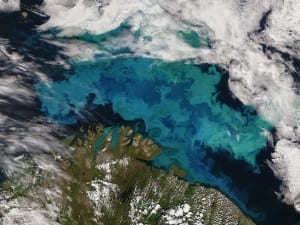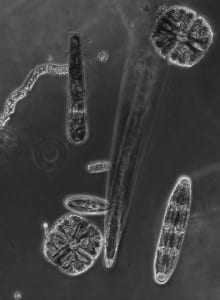When people ask what I do with my life and I reply that I’m doing my PhD in Marine Biology they immediately expect that I train dolphins or that I spend 12 hours a day in a wetsuit and jet off to some remote coral reef for 6 months a year. But when I tell them I research microscopic algae I always get the same reaction which usually begins with a disappointed “…Oh”; almost as if all hopes of an exciting and adventurous story about me wrestling a giant squid have been dashed.
At the start of my degree, I too thought of phytoplankton as pointless organisms that merely provided food for other small pointless creatures – and was simply something we all had to learn before being taught about the cool ‘flagship’ species of the marine world…How wrong I was!
I am hopefully going to summarise in a few paragraphs some of the key (but not so well known) facts about phytoplankton that ignited my interest in them, and hopefully will change that disappointed “…Oh” into an “OH!!”.
Thank Phytoplankton for every other breath you take!
The average human breathes 12 times a minute, and in the 60 seconds it took for you to read the above text – the phytoplankton themselves theoretically provided you with oxygen for roughly 30 of those seconds. Field et al. (1998) calculated that phytoplankton produce 50% of the worlds’ oxygen supply; however other researchers have suggested that this value could be as high as 70%.
So are phytoplankton really that important to us? The answer is clearly Yes!
Not just a green speck.
Think phytoplankton all look the same? Think again! Size varies tremendously between species – over 4 orders of magnitude! This scale difference between the smallest (Prochlorococcus) and largest (Trichodesmium) genus would be similar to the scale difference between a Red Ant and a Blue Whale.
Picture an obscure shape in your minds eye; chances are a species of phytoplankton exists in this format. The array of morphological configurations of these microscopic plants is truly astounding and often act to optimise a cells position within the water column. Some species have opted for more simple ellipsoid shapes; but coupled with their own methods of propulsion some can swim a distance of 30 body lengths in a single second!
Creators of Cliffs and Clouds
The White Cliffs of Dover, created by a plant…a plant that could pass through the eye of a needle with ease…doesn’t sound possible does it! But it’s true! Coccolithophores are a genus of phytoplankton that have characteristic calcium carbonate plates encompassing their surface. Over eons, these phytoplankter sank deep down into the sediment before being forced upwards to form the famous cliffs.
Although dependent on the sun, phytoplankton are sensitive to strong UV rays. When exposed to intense sunlight the cells create their own sunblock from DMSP. Bacteria then break this chemical down into DMS which filters from the ocean into the air, where it breaks down again to form tiny dust-like particles. These tiny particles are just the right size for water to condense on, which is the beginning of how clouds are formed.
So next time you see a murky green pond, remember just how much these ancient plants have impacted the world we live in today.

